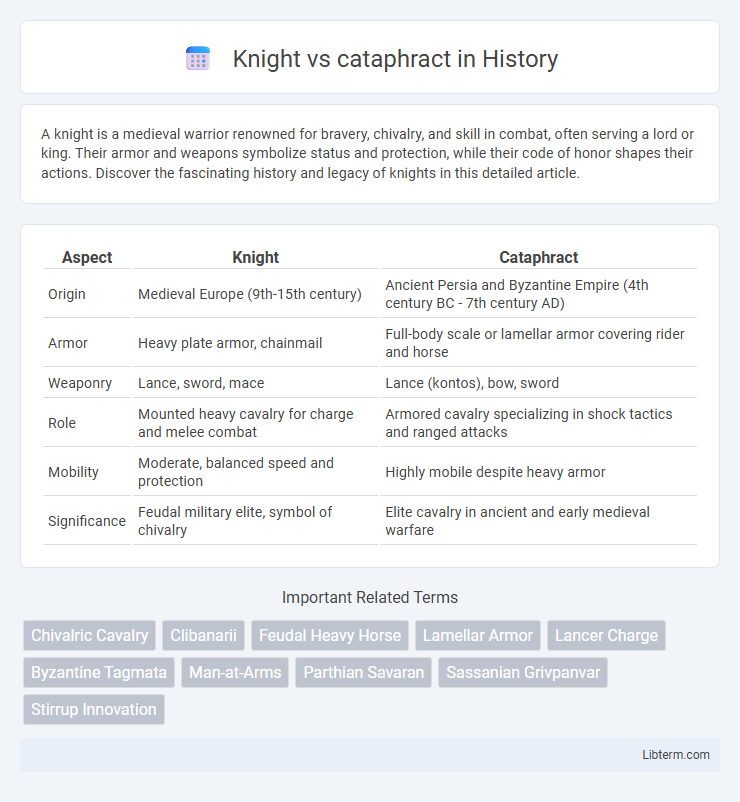A knight is a medieval warrior renowned for bravery, chivalry, and skill in combat, often serving a lord or king. Their armor and weapons symbolize status and protection, while their code of honor shapes their actions. Discover the fascinating history and legacy of knights in this detailed article.
Table of Comparison
| Aspect | Knight | Cataphract |
|---|---|---|
| Origin | Medieval Europe (9th-15th century) | Ancient Persia and Byzantine Empire (4th century BC - 7th century AD) |
| Armor | Heavy plate armor, chainmail | Full-body scale or lamellar armor covering rider and horse |
| Weaponry | Lance, sword, mace | Lance (kontos), bow, sword |
| Role | Mounted heavy cavalry for charge and melee combat | Armored cavalry specializing in shock tactics and ranged attacks |
| Mobility | Moderate, balanced speed and protection | Highly mobile despite heavy armor |
| Significance | Feudal military elite, symbol of chivalry | Elite cavalry in ancient and early medieval warfare |
Origins of Knights and Cataphracts
Knights originated in medieval Europe during the 8th to 12th centuries, evolving from mounted warriors who served feudal lords and played key roles in chivalric orders and cavalry tactics. Cataphracts emerged earlier in ancient Persia around the 4th century BCE, known for heavily armored horsemen utilizing both offensive and defensive armor on riders and horses to dominate battlefields in Near Eastern and later Byzantine armies. The development of knights was influenced by feudal society and Christian values, while cataphracts were rooted in the military traditions of Eastern empires and nomadic horse culture.
Geographic Spread and Influence
Medieval knights primarily dominated Western Europe, especially in regions like England, France, and the Holy Roman Empire, where feudalism structured military and social organization. Cataphracts, heavily armored cavalry units, were prevalent across Eastern Europe, Central Asia, and the Middle East, notably within the Byzantine, Sassanian, and early Islamic empires, influencing cavalry tactics across these vast territories. The geographic spread of cataphracts extended along the Silk Road, facilitating cultural and military exchanges, while knights largely shaped Western European warfare during the High and Late Middle Ages.
Armor and Protective Equipment Comparison
Knights wore plate armor composed of interlocking steel plates, providing comprehensive protection against swords, arrows, and blunt weapons while maintaining flexibility. Cataphracts utilized lamellar armor made of small iron or bronze scales laced together, offering excellent defense against piercing and slashing attacks, especially effective for mounted combat. Helmets for knights included visored bascinets enhancing facial protection, whereas cataphracts often donned conical or spangenhelm helmets with nasal guards for lightweight yet sturdy head coverage.
Weaponry and Combat Tactics
Knights wielded weapons such as lances, longswords, and maces designed for versatile combat, emphasizing heavy cavalry charges and close-quarters melee fighting. Cataphracts employed composite bows, lances, and curved swords, combining ranged and shock tactics to maximize flexibility on the battlefield. Their combat strategies involved coordinated unit formations capable of rapid engagement and swift withdrawal, contrasting with the heavily armored, direct assault style of knights.
Role in Medieval Warfare
Knights served as heavily armored cavalry specializing in shock combat, using lances and swords to break enemy lines and lead charges during medieval battles. Cataphracts were elite, heavily armored horsemen dominant in Eastern and Byzantine armies, combining heavy armor with archery skills for both offensive and defensive roles. Both units played crucial roles in medieval warfare, with knights excelling in Western European feudal armies and cataphracts influencing cavalry tactics through their mobility and armored versatility.
Training and Social Status
Knights underwent rigorous training from a young age, often starting as pages and squires, focusing on horsemanship, weapon mastery, and chivalric codes, reflecting their noble birth and elite social status in medieval European feudal society. Cataphracts, heavily armored cavalry from ancient Eastern empires like Byzantium and Persia, trained intensively in combined arms tactics, emphasizing discipline and coordination, typically drawn from aristocratic or military elite classes. Both warriors symbolized high social ranks, with their specialized training reinforcing their roles as dominant mounted forces in their respective cultures.
Mobility and Horses
Knights traditionally rode heavily armored horses designed for shock combat but sacrificed speed and agility, limiting their battlefield mobility to direct charges and close combat. Cataphracts utilized lighter barding and often more maneuverable horses, enabling quicker movements and more flexible tactics such as hit-and-run attacks and flanking maneuvers. The superior mobility of cataphract cavalry allowed them to adapt to diverse terrains and maintain battlefield dominance through rapid redeployment.
Notable Battles and Campaigns
Knights played a decisive role in the Battle of Hastings (1066), where their heavy cavalry charge broke the English shield wall, securing Norman conquest. Cataphracts were crucial in the Battle of Carrhae (53 BCE), using their armored charge to outmaneuver Roman legions. The Crusades showcased knights in prolonged sieges and pitched battles, while cataphracts dominated early Byzantine and Sassanian clashes, leveraging their mobility and armor on varied terrains.
Decline and Legacy
The decline of knights in medieval warfare corresponded with the rise of more heavily armored and strategically versatile cataphracts, who utilized superior cavalry tactics and integrated weapons systems to dominate battlefield engagements. Cataphracts' legacy influenced the evolution of heavy cavalry across Europe and Asia, contributing to the development of early armored units that combined mobility with powerful offensive capabilities. The transition marked a shift from the heavily armored but less flexible knights to more dynamic and adaptive mounted warriors, shaping military doctrines for centuries.
Cultural Impact and Representation
Knights symbolize medieval European chivalry, embodying ideals of honor and feudal loyalty, which have been extensively depicted in Western literature and art, cementing their cultural legacy. Cataphracts represent the elite armored cavalry of ancient Eurasian empires, influencing military strategies and iconography in Byzantine and Sassanian cultures. Both entities serve as cultural archetypes in historical narratives and reenactments, highlighting differing martial traditions and societal values across regions.
Knight Infographic

 libterm.com
libterm.com